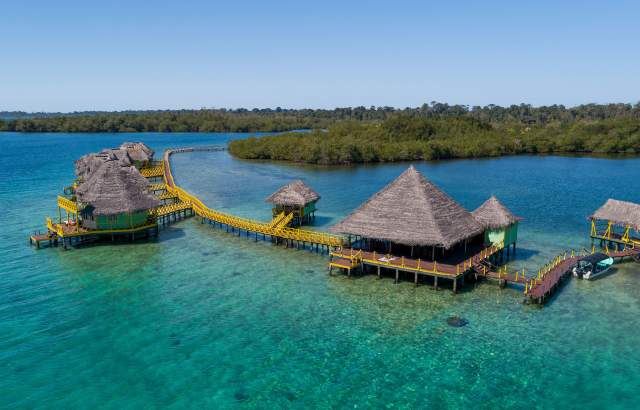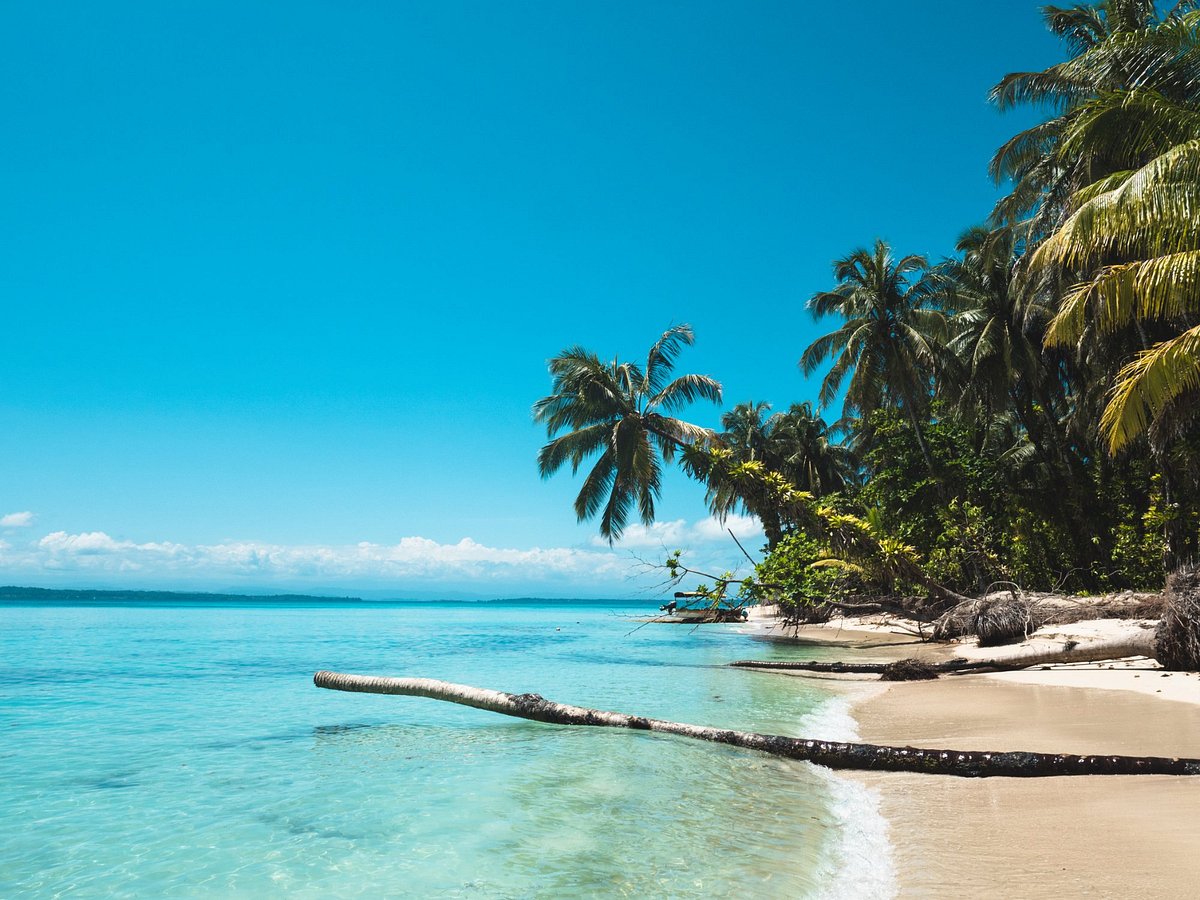



Bocas del Toro Town, or just Bocas Town, is the capital of Bocas del Toro Province, in Panama. It's at the southern tip of Isla Colón, in the Caribbean Sea. Nearby beaches include sheltered Starfish Beach, to the northwest. Bluff Beach, on the east coast, is known for its strong surf. To the north, rocky Bird Island is home to the rare red-billed tropicbird. In town, artisans sell local crafts in Simón Bolívar Park. ― Google
Dry Seasons:
January–March and September–October (yes, these are mini dry seasons!) — best for beach weather, diving, and outdoor fun.
Rainy Season: April–August, November–December — still warm, but expect frequent tropical showers (often at night or briefly during the day).
From Panama City:
✈️ Flight: 1-hour direct flight to Bocas del Toro "Isla Colón" Airport (BOC) from Albrook Airport.
🚌 + 🚤 Bus + Boat: Overnight bus (~10 hrs) to Almirante, then water taxi (~30 min) to Bocas Town.
From Costa Rica: Shuttle or bus to Almirante, then boat over.
Starfish Beach (Playa Estrella): Clear water and loads of starfish (please don’t touch them!).
Red Frog Beach (Isla Bastimentos): Surf, swim, or spot red poison dart frogs.
Bluff Beach: Wild, beautiful surf beach. Great for a walk or sunbathing.
Isla Zapatilla: Pristine, uninhabited island — part of Bastimentos Marine National Park.
Bocas Town: Colorful wooden houses, lively restaurants, and nightlife.
Snorkeling & Diving: Coral Cay, Hospital Point, and Dolphin Bay are top spots.
Island-hopping by water taxi: Explore Isla Carenero, Isla Bastimentos, and beyond.
Surfing: Especially around Bluff Beach and Isla Carenero.
Bioluminescence Tours: Nighttime kayak or boat trips to see glowing plankton.
Dolphin watching: Go early in the morning for better chances.
Chocolate farm tours and jungle hikes on Isla Bastimentos.
Volunteer opportunities at wildlife or conservation projects.
Luxury:
Red Frog Beach Island Resort (Bastimentos)
Azul Paradise (Overwater bungalows on Isla Bastimentos)
Mid-range:
Tropical Suites Hotel (Bocas Town)
Island Plantation (Eco-lodge at Bluff Beach)
Budget:
Selina Bocas del Toro (Great for digital nomads & backpackers)
Skully’s House (fun, beachfront hostel with a bar and pool)
Vitebsk Best time to visit: How to get there: Top attractions: Activities todo: Accommodation: Food and restaurant: Local culture:
Sure! Here’s a concise travel guide for Vitebsk, Belarus covering the points you asked:
Late spring to early autumn (May to September) is ideal for pleasant weather, outdoor events, and festivals.
The famous Slavianski Bazaar in July is a highlight, attracting many visitors.
Winters (December to February) are cold and snowy, great if you enjoy winter landscapes but less ideal for sightseeing.
By Air: The nearest major airport is in Minsk (Minsk National Airport), about 300 km away. From Minsk, you can take a train or bus to Vitebsk (3-4 hours).
By Train: Vitebsk has good rail connections with Minsk, Moscow, and Saint Petersburg.
By Bus: Regular buses run from Minsk and other Belarusian cities.
By Car: Accessible via the M3 highway from Minsk.
Marc Chagall Museum: Dedicated to the famous painter born in Vitebsk.
Vitebsk Regional Museum: Local history and culture.
Church of St. Barbara: Beautiful Orthodox church with historic architecture.
Victory Square: Central square with monuments and cafes.
Annunciation Church: One of the oldest churches, with stunning interiors.
Lenin Square: City center with shops and theaters.
Vitebsk City Hall: Historic building and cultural site.
Attend the Slavianski Bazaar international arts festival in July.
Explore local parks such as Victory Park.
Walk along the Dvina River embankment.
Visit local theaters and galleries.
Take a day trip to the Braslav Lakes National Park nearby.
Try fishing or boating on the Western Dvina River.
Options include several mid-range hotels and guesthouses near the city center.
Some recommended hotels:
Vitebsk Hotel (central, comfortable)
Europe Hotel
Park Hotel
For budget travelers, small hostels and local guesthouses are available.
Traditional Belarusian dishes to try: Draniki (potato pancakes), Borscht, and Kalduny (dumplings).
Popular local restaurants:
Skovorodka (traditional cuisine)
Vasilki (Belarusian dishes)
Bistro Smile (casual dining)
Cafes and bakeries offering local pastries and coffee are widespread.
Vitebsk is known as the cultural capital of Belarus, famous for its art scene.
Birthplace of artist Marc Chagall, the city hosts various art exhibitions and festivals.
The Slavianski Bazaar celebrates Slavic music and arts with performances from across Eastern Europe.
Local people are friendly and proud of their cultural heritage.
The city’s architecture reflects a mix of historical styles, from Baroque to Soviet-era buildings.
If you want, I can help you with more detailed itineraries or tips for your visit!
Panama City
Here’s a detailed travel guide for Panama City, Panama:
Dry Season (Mid-December to April) is the best time — sunny days, less humidity, ideal for sightseeing and beach trips.
Wet Season (May to November) has daily rains, but it’s usually cheaper and less crowded.
By Air:
Fly into Tocumen International Airport (PTY) — a major hub in Latin America.
30-45 minutes by taxi or shuttle to downtown.
By Bus:
Domestic buses connect from cities like David, Colón, or Bocas del Toro.
By Sea:
Some Caribbean cruises stop in Panama City (via Colón or Amador Causeway).
Panama Canal (Miraflores Locks): Watch ships pass and explore the visitor center.
Casco Viejo: Colonial Old Town with cobblestone streets, cathedrals, plazas, rooftop bars.
Biomuseo: Frank Gehry-designed museum focusing on biodiversity.
Amador Causeway: Scenic road connecting islands — great views of the skyline.
Panama Viejo: Ruins of the original 16th-century city.
Cinta Costera: Seafront promenade perfect for walks or biking.
Panama Canal Tour: Visit locks or take a partial/full canal boat tour.
Hiking in Metropolitan Natural Park: A rainforest in the city with wildlife and skyline views.
Take a day trip to San Blas Islands or Taboga Island for white-sand beaches and crystal waters.
Shopping in Albrook Mall: One of the largest in the Americas.
Salsa dancing or rooftop nightlife in Casco Viejo.
Luxury:
American Trade Hotel (Casco Viejo)
W Panama
Sofitel Legend Casco Viejo
Mid-range:
Hotel Riu Plaza Panama
Tryp by Wyndham
Budget:
Selina Casco Viejo (Hostel with vibe)
Luna's Castle Hostel
Local dishes to try:
Sancocho (chicken stew)
Ropa Vieja (shredded beef)
Ceviche (fresh seafood)
Popular Restaurants:
Donde José – Fine Panamanian tasting menu
Mercado de Mariscos – Local fish market with cheap, fresh ceviche
Fonda Lo Que Hay – Trendy local flavors
Maito – Listed in Latin America’s 50 Best
Blend of Indigenous, Spanish, Afro-Caribbean, and U.S. influence.
Casco Viejo is a cultural heart, with art galleries, jazz cafes, and historic churches.
Carnival (February/March) is the biggest festival — vibrant parades and music.
Spanish is the official language, but English is commonly spoken in tourist areas.
Panama’s economy and infrastructure are highly developed compared to many in the region.
Let me know if you want a 3-day itinerary, day trips, or info on nightlife, public transport, or safety tips!
Boquete
Here's your full Boquete, Panama travel guide:
Dry Season (December to April): Ideal weather for hiking, ziplining, and exploring nature.
Green Season (May to November): Lush scenery, fewer crowds — afternoon showers are common but usually short.
Best month: March — perfect climate and wildflower bloom.
From Panama City:
✈️ Fly to David Airport (DAV) (1 hour), then drive or bus 45 mins to Boquete.
🚌 Bus from Albrook Terminal to David (~7 hours), then local bus/taxi.
🚗 Drive: ~7 hours via Pan-American Highway.
Volcán Barú: Highest point in Panama. You can hike or take a 4x4 tour to see both Pacific and Caribbean on clear days.
The Lost Waterfalls Trail: A scenic hike to three stunning waterfalls.
Boquete Tree Trek: Zipline through cloud forest canopies.
Caldera Hot Springs: Rustic thermal springs near Boquete for a relaxing soak.
Boquete Flower and Coffee Fair (Feria de las Flores y del Café): Held in January, celebrating the region’s blooms and brews.
Coffee Tour: Visit plantations like Finca Lérida or Finca Dos Jefes and taste world-famous Geisha coffee.
Hiking: Sendero El Pianista, Quetzal Trail, and Pipeline Trail are popular.
Whitewater rafting on the Chiriquí Viejo River.
Birdwatching: Spot quetzals and hummingbirds in the cloud forest.
Rock climbing, horseback riding, and yoga retreats are also available.
Luxury:
The Haven & Spa – Adults-only wellness retreat
Valle Escondido Resort – Golf, spa, and mountain views
Mid-range:
Boquete Garden Inn – Beautiful gardens and wildlife
Hotel Panamonte – Historic, with a great restaurant
Budget:
Bambuda Castle – Unique castle hostel with a pool
Spanish by the River – Hostel + Spanish school
Local dishes to try:
Sancocho (chicken soup)
Tamales wrapped in banana leaves
Fresh trout, often grilled
Popular spots:
The Rock – Fine dining with great views
RetroGusto Restaurant & Bar – Italian/Panamanian fusion
Sugar & Spice – Breakfast, baked goods, and local treats
Big Daddy’s Grill – Casual spot for tacos and drinks
A blend of indigenous Ngäbe-Buglé traditions, expat influence, and Panamanian mountain life.
Coffee farming is central to life here.
Locals are friendly, and many people speak English due to the expat community.
Weekly farmers markets, craft fairs, and art events are common.
Safe, clean, and nature-focused — it’s one of Panama’s most beloved small towns.
Would you like a 3-day itinerary, best hikes, or details on living/retirement in Boquete?
Bocas del Toro
Here’s your complete Bocas del Toro, Panama travel guide:
Dry Seasons:
January–March and September–October (yes, these are mini dry seasons!) — best for beach weather, diving, and outdoor fun.
Rainy Season: April–August, November–December — still warm, but expect frequent tropical showers (often at night or briefly during the day).
From Panama City:
✈️ Flight: 1-hour direct flight to Bocas del Toro "Isla Colón" Airport (BOC) from Albrook Airport.
🚌 + 🚤 Bus + Boat: Overnight bus (~10 hrs) to Almirante, then water taxi (~30 min) to Bocas Town.
From Costa Rica: Shuttle or bus to Almirante, then boat over.
Starfish Beach (Playa Estrella): Clear water and loads of starfish (please don’t touch them!).
Red Frog Beach (Isla Bastimentos): Surf, swim, or spot red poison dart frogs.
Bluff Beach: Wild, beautiful surf beach. Great for a walk or sunbathing.
Isla Zapatilla: Pristine, uninhabited island — part of Bastimentos Marine National Park.
Bocas Town: Colorful wooden houses, lively restaurants, and nightlife.
Snorkeling & Diving: Coral Cay, Hospital Point, and Dolphin Bay are top spots.
Island-hopping by water taxi: Explore Isla Carenero, Isla Bastimentos, and beyond.
Surfing: Especially around Bluff Beach and Isla Carenero.
Bioluminescence Tours: Nighttime kayak or boat trips to see glowing plankton.
Dolphin watching: Go early in the morning for better chances.
Chocolate farm tours and jungle hikes on Isla Bastimentos.
Volunteer opportunities at wildlife or conservation projects.
Luxury:
Red Frog Beach Island Resort (Bastimentos)
Azul Paradise (Overwater bungalows on Isla Bastimentos)
Mid-range:
Tropical Suites Hotel (Bocas Town)
Island Plantation (Eco-lodge at Bluff Beach)
Budget:
Selina Bocas del Toro (Great for digital nomads & backpackers)
Skully’s House (fun, beachfront hostel with a bar and pool)
Local specialties:
Fresh ceviche, coconut rice, plantains, and seafood stew.
Popular spots:
El Ultimo Refugio – Creative seafood with a sunset view
Bibi’s on the Beach (Carenero) – Waterfront Caribbean fare
Raw Fusion – Sushi and Asian-fusion
Leaf Eaters Café – Vegan/vegetarian on the water
The Floating Bar – Chill vibes on the sea with snacks and drinks
Strong Afro-Caribbean influence: language, music (reggae, calypso), and food.
Mix of indigenous Ngäbe-Buglé, Panamanians, expats, and backpackers.
Laid-back island life with a vibrant, youthful energy.
Many locals speak English and Spanish.
Colorful festivals like Carnival (Feb/Mar) and Sea Fair (September).